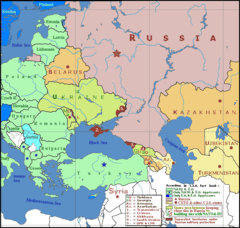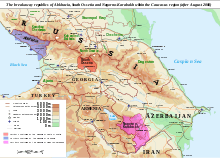Post-Soviet conflicts
This article lists the post-Soviet conflicts, the violent political and ethnic conflicts in the countries of the former Soviet Union since shortly before its official breakup in December 1991.

Some of these conflicts such as the 1993 Russian constitutional crisis or the 2013 Euromaidan protests in Ukraine were due to political crises in the successor states. Others involved separatist movements attempting to break away from one of the successor states.
According to Gordon M. Hahn, between 1990 and 2013 the post-Soviet conflicts led to the death of at least 196,000 people, excluding pogroms and interethnic violence.[1]
Frozen conflicts

Some post-Soviet conflicts ended in a stalemate or without a peace treaty, and are referred to as frozen conflicts. This means that a number of former-Soviet states are left sovereign over the entirety of their territory in name only. In reality, they do not exercise full control over areas still under the control of rebel factions. Rebel groups are essentially left independent over large chunks of the territories they claim. In many instances, they have created institutions which are similar to those of fully fledged independent states, albeit with little or no international recognition. Notable such cases include Abkhazia and South Ossetia in Georgia; Nagorno-Karabakh on the border between Azerbaijan and Armenia; Transnistria in land near to Moldova's eastern border with Ukraine; and the Donetsk People's Republic and the Luhansk People's Republic breakaway areas in Ukraine.[2] The Republic of Crimea is also arguably part of this group of unrecognised states, as the annexation of Crimea by the Russian Federation remains unrecognized by a majority of UN member states and is contested by the government of Ukraine.
Recognition of these rebel groups vary. In some instances such as Transnistria, no UN-member state has given its recognition, including Russia. In the case of Georgia's Abkhazia and South Ossetia, Russia, Venezuela, Nicaragua, Nauru and Syria have recognized them.
Central Asia
| Conflict | Start | End | Detail |
|---|---|---|---|
| 1992 | 1997 | Began when ethnic groups from the Gharm and Gorno-Badakhshan regions of Tajikistan, which were underrepresented in the ruling elite, rose up against the national government of President Rahmon Nabiyev, in which people from the Leninabad and Kulob regions dominated. The war ended with the signing of the "General Agreement on the Establishment of Peace and National Accord in Tajikistan" and the "Moscow Protocol".[3] | |
| 2010 | 2010 | Clashes between ethnic Kyrgyz and Uzbeks in southern Kyrgyzstan, primarily in the cities of Osh and Jalal-Abad, in the aftermath of the ouster of former President Kurmanbek Bakiyev on April 7. | |
| 2010 | 2015 | Sporadic fighting in Tajikistan between rebel and government forces. | |
North Caucasus
| Conflict | Start | End | Detail |
|---|---|---|---|
| 1992 | 1992 | Inter-ethnic conflict in the Eastern part of the Prigorodny district. | |
| 1994 | 1996 | Russian troops invaded after Chechnya declared independence, but withdrew in 1996 leading to a de facto Chechen independence. | |
| 1999 | 1999 | The Islamic International Brigade invaded the neighbouring Russian republic of Dagestan in support of the Shura of Dagestan separatist movement. | |
| 1999 | 2000 | Russia restores federal control of Chechnya. | |
| 2000 | 2009 | Separatist insurgency in Chechnya, Dagestan, and other parts of the North Caucasus region. | |
| 2007 | 2015 | Separatist insurgency in Ingushetia. | |
| 2009 | 2017 | Separatist insurgency in Chechnya, Dagestan, and other parts of the North Caucasus region. |
South Caucasus
| Conflict | Start | End | Detail |
|---|---|---|---|
| 1988 | 1994 | Ethnic Armenian separatism leads to the de facto independence of the Republic of Artsakh. | |
| 1991 | 1992 | The separatist conflict leads to South Ossetia's de facto independence. | |
| 1991 | 1993 | Inter-ethnic and intranational conflicts in the regions of South Ossetia and Abkhazia. | |
| 1992 | 1993 | Abkhaz separatism leads to the de facto independence of Abkhazia from Georgia. | |
| 1994 | — | Sporadic border war on the Armenian–Azerbaijan border and at the line of contact between the Nagorno-Karabakh and Azerbaijan. | |
| 1998 | 1998 | Ethnic Georgians launched an insurgency against the Abkhazian secessionist government. | |
| 2002 | 2004 | An incursion by Al-Qaeda forces on behalf of Chechen rebels fighting in the North Caucasus. They were forced out in 2004 by Georgian forces with American and Russian backing. | |
| 2004 | 2004 | A popular revolt ousted the autocratic ruler Aslan Abashidze, Adjara reaffirmed its integration into Georgia as an autonomous republic. | |
| 2008 | 2008 | A war between Georgia on one side and Russia, South Ossetia and Abkhazia on the other side confirms the de facto independence of Abkhazia and South Ossetia and leads to their recognition by Russia and Nicaragua.[4] |
Eastern Europe
| Conflict | Start | End | Detail |
|---|---|---|---|
| 1992 | 1992 | Transnistria, which is de facto independent from Moldova, has declared independence in 1990, due to its majority Russian-speaking population fearing union with Romania. A ceasefire between Transnistrian forces and Moldovan forces has been in place since 1992, enforced by the presence of Russian forces in Transnistria.[5] | |
| 1993 | 1993 | Political stand-off between the Russian president and the Russian parliament that was resolved by using military force. | |
| 2013 | 2014 | Civil unrest fueled by the perception of widespread government corruption, abuse of power and violation of human rights in Ukraine. The unrest eventually lead to the 2014 Ukrainian Revolution toppling of the Ukrainian government. | |
| 2014 | — | In March 2014, following the takeover of Crimea by pro-Russian separatists and Russian Armed Forces,[6] an unauthorised and unrecognised[7] referendum was held on the issue of reunification with Russia.[8] Russia then annexed Crimea. Then Violent protests of the Russian population began in Donetsk and Luhansk Oblasts, which turned into a full-fledged war. |
See also
- Community for Democracy and Rights of Nations
- List of wars 1990–2002
- List of wars 2003–2010
- List of wars 2011–present
- Post-Soviet states
References
- Hahn, Gordon M. (2017). Ukraine Over the Edge: Russia, the West and the "New Cold War". McFarland. ISBN 9781476628752.
- Rusif Huseynov. Ukraine: Towards a frozen future?: The Politicon, 11 November 2015
- Tajikistan Civil War Global Security
- "Statement by President of Russia Dmitry Medvedev". Russia's President web site. 2008-08-26. Archived from the original on 2 September 2008. Retrieved 2008-08-26.
- "Trans-Dniester profile - BBC News". news.bbc.co.uk. Retrieved 2017-06-18.
- "Meeting of the Valdai International Discussion Club". Kremlin.ru. 2014-10-24. Archived from the original on 2015-04-15.
I will be frank; we used our Armed Forces to block Ukrainian units stationed in Crimea
- "Treasury Designates Seven Individuals And One Entity Contributing To The Situation In Ukraine". US Treasury. 11 April 2014.
- "Crimea applies to be part of Russian Federation after vote to leave Ukraine". The Guardian. 17 March 2014.